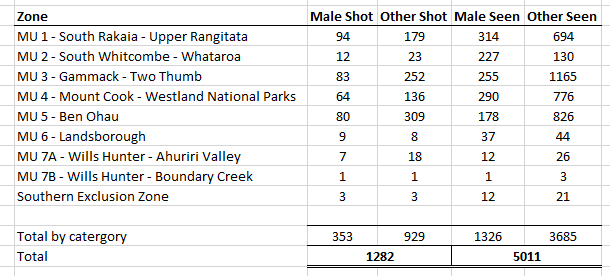- Recreational hunting
- The recreational hunting returns on the DOC website as at 8 April 2019 are shown in the table below.

-
- Following the Tahr Liaison Group meeting in March the Tahr Foundation and DOC facilitated five groups to undertake recreational hunting in South Westland (as a result from the opportunity being discussed at the meeting). Work is underway on how these opportunities could be extended in the future.
- The Tahr Foundation, NZDA and GAC are working together on a verification approach for recreational hunting. The purpose of that work has been agreed as ‘to provide an assessment of publicly available hunting apps that could be trialled by recreational hunters to record tahr kills’.
- Tahr research and monitoring
- Tahr Liaison Group members have been invited to the GAC and DOC hosted workshop on 9 May. The purpose of the workshop is ‘To identify the key research and monitoring questions for effectively implementing the 1993 Himalayan Thar Control Plan: What do we know and what do we need to know about?’. Reminder to please respond to both Geoff Kerr and James Holborow on attendance.
- The Department has commissioned a short report from Manaaki Whenua Landcare Research to support context setting at that workshop – the purpose is ‘To provide a concise overview of the current state of tahr knowledge’. Manaaki Whenua Landcare Research may be in touch with some of you for information to support their work.
- DOC tahr control
- The Department has commenced work in the Northern exclusion zone – where judas tahr have been a key tool in that control work. DOC work from now through to the end of June will concentrate on the Northern and Southern Exclusion zones and other pockets of animals beyond the defined feral range – important work to prevent range expansion.
- No DOC control has been undertaken in the management units since the announcement of the tahr programme recommencing (and will not until 1 July). I have heard of anecdotal reports of some helicopter hunting - any activity in the management units will be from AATH operators or Zero Invasive Predators undertaking tahr recovery (limited numbers of tahr as advised at the Tahr Liaison Group meeting).
- The majority of the 10,000 tahr to be controlled by 30 August 2019 will occur over July and August 2019. DOC has been working on the detail of that, which may include tahr control from a range of known and potential sources (i.e., organised recreational hunting; AATH trophies; AATH offsets; tahr carcass recovery – WARO; contract control; and DOC control).
- Vegetation report
- At the Tahr Liaison Group meeting it was noted that a report on ‘ Potential of Tier One and alternative monitoring networks to assess the ecological integrity of alpine vegetation exposed to tahr grazing’ had been completed. I was waiting on the development of a summary report and factsheet – this will be available next week (slightly later than I had hoped). I will provide copies to the Tahr Liaison Group of the three documents next week – they will also be useful context for the research and monitoring workshop.
- Post 30 August 2019
- As previously stated the Department will lead a process for the development of the approach for tahr management post 30 August 2019. We will certainly be working with the Tahr Liaison Group as part of that – more detail on how we can work together on this to come shortly.
- Tahr abundance monitoring
- As outlined at the Tahr Liaison Group meeting aerial surveys have been undertaken over the last 6 weeks across public conservation land. LINZ and DOC are working with crown pastoral leaseholders to undertake aerial surveys on crown pastoral land.
